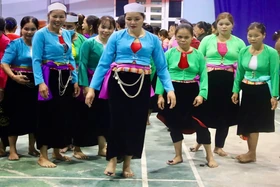{title}
{publish}
{head}
Cassava cake has long been a beloved specialty of the people in the Land of the Hung Kings. Each region, and even each household, has its own method of making this cake. However, not everyone can craft a cassava cake that’s delicious, rich in traditional flavor, and cherished by many. Ms. Tran Thi Viet Ha, the owner of the Thu Ha Cassava Cake brand in Ha Hoa Town, Ha Hoa District, is one such person. She has created a distinctive flavor that leaves a lasting impression on those who taste it.
Cassava cake has existed for generations. In the past, it was known as a humble food — a way for poor families to stave off hunger, as it was made from cassava, a cheap and readily available ingredient. Back then, the cake had no filling. People would poke a hole in the middle using chopsticks to help it cook faster and more evenly, which led to its nickname: "chopstick cassava cake." Today, the simple version has evolved into cakes with fillings, such as sweet mung bean or savory meat.

Ms. Tran Thi Viet Ha introduces her cassava cake.
In Phu Tho, most people know how to make cassava cake. But turning it into a recognizable brand with a solid place in the market is a different story. According to Ms. Ha, the idea for her brand — Thu Ha Cassava Cake — started quite unexpectedly. In 2023, during a reunion of the Canh Tuat Vietnam group, she wanted to introduce a typical dish from the Land of the Ancestors to her fellow group members across the country. After much thought, she decided to make cassava cake using her family’s traditional recipe.
She specifically chose cassava with low moisture and high starch content — a decision that requires experience and a good understanding of cassava varieties and growing regions. Once harvested, the cassava is peeled, soaked, and washed. It’s then chopped into small pieces and soaked again to remove the pungent odor.
Depending on the weather, cassava may be soaked for 5 to 10 days, with the water changed daily, until the smell disappears. This step is crucial to ensure the final product doesn’t have an unpleasant taste or cause a burning sensation in the throat. Once dried, the cassava is ground into flour for storage. The dough is kneaded with boiling water until it becomes smooth and pliable enough for shaping.
Besides the dough, the filling plays a crucial role in defining the cake’s flavor. While some people use a combination of mung bean and coconut, Ms. Ha only produces savory cassava cakes — made with green beans, pork, shallots, and wood ear mushrooms. She uses mostly pork shoulder and crispy pork head, ensuring the meat is freshly butchered for the best texture and taste. When steamed, the filling binds well and doesn’t fall apart.


The Thu Ha savory cassava cake product received a 3-star OCOP certification in 2024.
Ms. Ha shared that most cassava cakes on the market weigh about 0.5 grams each. However, her production facility makes larger cakes — about 0.8 grams per cake — giving Thu Ha products a recognizable distinction. Each cake is sold for around VND 8,000.
After shaping, the cakes are frozen until firm, then vacuum-sealed for long-term preservation. When stored properly, they can last for up to six months without compromising quality. On average, Ms. Ha’s facility produces about 3,000 cakes a day. During the peak season — particularly during the Hung Kings’ Commemoration Day and Culture-Tourism Week — production ramps up to 10,000 cakes per day, with ten full-time workers.

Thu Ha’s savory cassava cakes on display during the Hung Kings’ Commemoration Day and Culture-Tourism Week.
Thanks to its affirmed quality and branding, the Thu Ha savory cassava cake was awarded a 3-star OCOP certificate in 2024. Its market has since expanded both inside and outside the province. The cakes are featured in many major restaurants and have received high praise from customers. When eaten, the cake delivers a chewy, slightly rich cassava flavor blended with the savory taste of pork, the fragrance of shallots, and the nuttiness of mung beans. When paired with sesame salt, the flavor becomes even more irresistible.
With its unique taste and connection to the Land of the Ancestors, this cassava cake has become a heartfelt gift — a delicious token of welcome to guests from near and far.
Vinh Ha

In recent years, the Department of Culture, Sports and Tourism of Phu Tho Province has paid close attention to the conservation and promotion of cultural heritage values.

baophutho.vn For the Muong people in Hoa Binh, gongs are not only musical instruments, but also a “sacred soul treasure” accompanying them from birth until...

baophutho.vn The Ministry of Culture, Sports and Tourism has officially announced the updated List of National Intangible Cultural Heritages. Following the...

baophutho.vn Set against the rich cultural backdrop of the mountains and forests, the cuisine of the Muong ethnic group has become an essential element in...

baophutho.vn On the morning of July 30, at Thuong Temple on Nghia Linh mountain within the Hung King Temple Historical Site, a delegation from the...

baophutho.vn Following the reorganization of commune-level administrative units, the Muong Vang region, formerly part of Lac Son district, was restructured...

baophutho.vn On the quiet Hill 79 in Hoa Binh Ward, nestled in the heart of the city along the Da River, lies a memory zone that quietly preserves the...

baophutho.vn The traditional art of creating skirt patterns among the Muong people, originally in Hoa Binh province, now part of Phu Tho province, has been...

baophutho.vn The Ministry of Culture, Sports, and Tourism has officially released the latest List of National Intangible Cultural Heritages, with the newly...

baophutho.vn The project to merge the three provinces of Phu Tho, Vinh Phuc, and Hoa Binh into a new Phu Tho province places high demands on solidarity and...